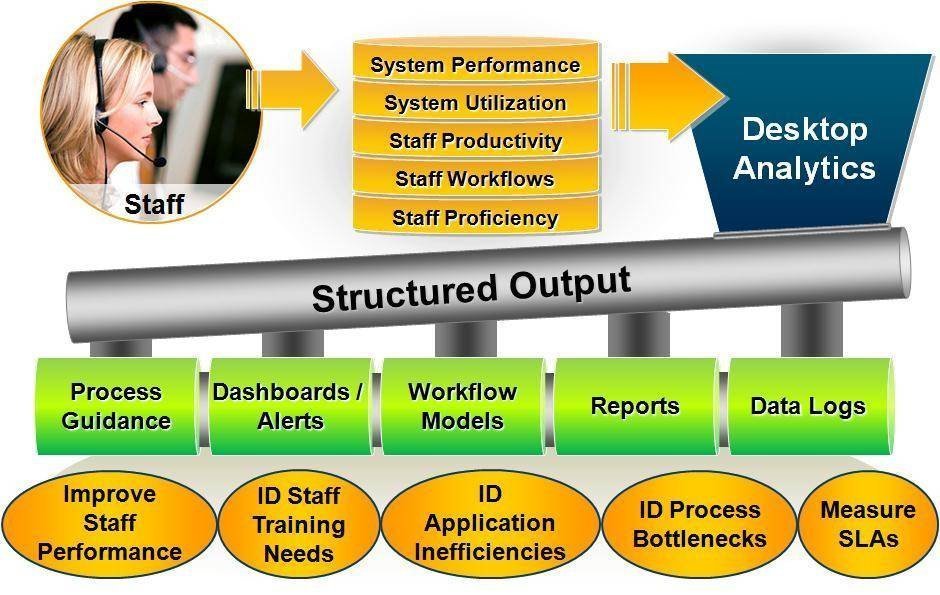Desktop analytics: A game changer for contact centers, back offices
Expert Donna Fluss says companies should consider a new type of analytics -- desktop analytics -- to accurately provide feedback on the contact center and the back office.
Desktop analytics remains an emerging and little-known or understood application. It is now evolving from its tactical heritage into a strategic capability that has the potential to enhance both contact center and back-office operating areas.
For more on contact center analytics
Read how speech analytics offer another option for agent monitoring
Get tips for measuring contact center analytics across channels
Discover how to use real-time analytics for up-selling and cross-selling
DMG Consulting LLC defines desktop analytics as “an automated and systemic approach to monitor, capture, structure, analyze and report on desktop activity and process workflows.” It features the ability to detect keystrokes, data entry content, applications used, screens and fields accessed events, usage duration and resulting actions. It measures application utilization, usage patterns and performance metrics to assess application and user efficiency, effectiveness, compliance and external customer impact. It also provides guidance and workflow-enabled process flows to enhance staff performance in real time (see Figure 1). The primary outputs from desktop analytics are the following:
- Real-time process guidance and next-best-action recommendations
- Identification of staff training needs
- Locating process bottlenecks
- Targeting application performance issues
- Measurement of adherence to service-level agreements (SLAs)

Figure 1. Desktop analytics defined Source: DMG Consulting LLC, December 2011
Desktop analytics applications are integrated behind the scenes. They sit on top of existing servicing applications and monitor employee activities to provide guidance for completing tasks accurately. They also monitor how employees use and interact with their servicing applications.
Contact center uses, benefits
Contact center agents are among the most rigorously scrutinized employees in the enterprise. They are held accountable for more performance metrics (over which they have only a modicum of control) than anyone in the organization. Historically, their performance has been assessed on the basis of quality assurance evaluations of, at best, three to five calls a month. They are held to stringent average handle times, yet are required to assimilate large volumes of information, navigate multiple systems and screens and meet all productivity and quality standards while attempting to create an outstanding service experience for the customer (and quite possibly trying to sell something as well).
More than any other contact center application, desktop analytics has the ability to significantly transform the agent experience and empower agents. It offers the following:
- Real-time process guidance that can be used to help employees do their jobs correctly
- Performance monitoring that can identify systems, process and employee operational and training opportunities based on an aggregate of all desktop activity performed by the agent
- Desktop automation to eliminate redundant tasks and reduce errors
These uses are each effective on a standalone basis. Used together, they deliver rapid and highly quantifiable benefits.
Back office uses, benefits
Back-office groups and activities have proliferated in many companies and government agencies, resulting in complex operating environments. DMG Consulting estimates that there are at least three times as many back-office employees as contact center agents in a typical organization, a ratio that is not likely to change. Back offices need tools to improve staff performance, quality and productivity. Managers need automation that provides transparency and actionable insights that they can use to drive a culture of continuous improvement and cost reduction.
Desktop analytics can improve staff performance by providing real-time guidance and identifying departmental and employee-specific system and processing issues so that they can be corrected or improved. Combined with operational best practices, desktop analytics has the potential to reduce processing time and cost while enhancing quality. It can also help improve the operating environment and make back-office work more rewarding for employees, and that results in a better customer experience.
Final thoughts
Desktop analytics is capable of providing great value and financial benefits. It provides transparency into what is happening at front- and back-office employees’ desktops and guides employees. As they help organizations prevent mistakes, desktop analytics applications deserve serious consideration.
ABOUT THE AUTHOR
Donna Fluss is the founder and President of DMG Consulting LLC, the leading provider of contact center and analytics research, market analysis and consulting.







